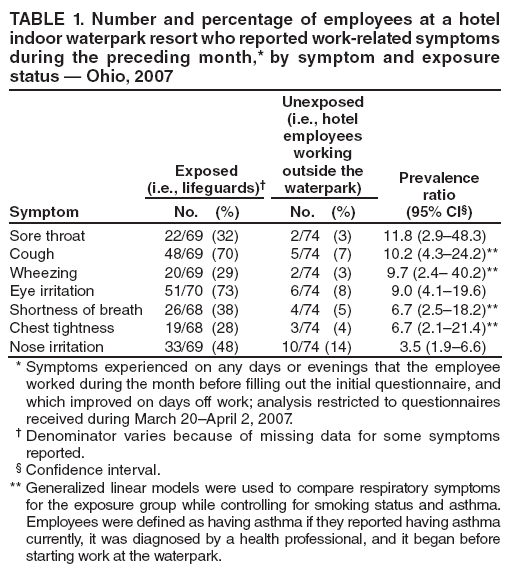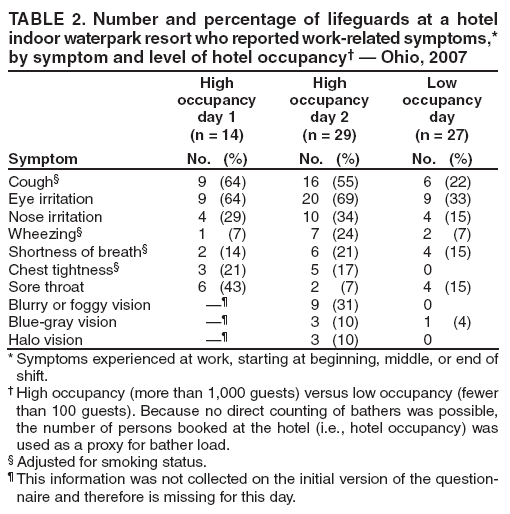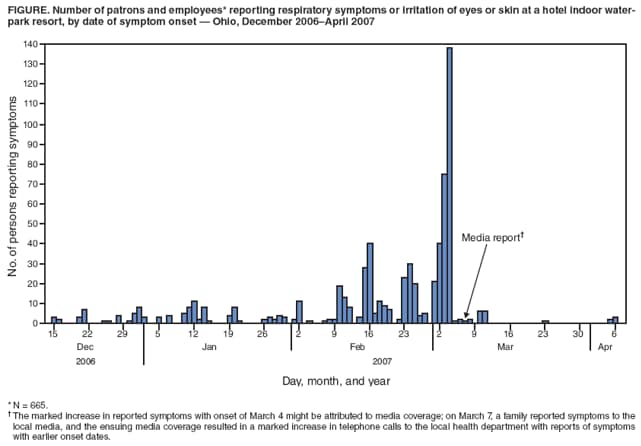 |
|
|
|
|
|
|
| ||||||||||
|
|
|
|
|
|
|
||||
| ||||||||||
|
|
|
|
|
Persons using assistive technology might not be able to fully access information in this file. For assistance, please send e-mail to: mmwrq@cdc.gov. Type 508 Accommodation and the title of the report in the subject line of e-mail. Respiratory and Ocular Symptoms Among Employees of a Hotel Indoor Waterpark Resort --- Ohio, 2007During January--March 2007, the Warren County Combined Health District (WCCHD) received 665 reports of respiratory and eye irritation from patrons and lifeguards at a hotel indoor waterpark resort in Ohio. Tests revealed normal water chemistry and air chlorine concentrations, and exposure to airborne trichloramine in the waterpark was suspected as the cause of the symptoms. Because of the number of symptom reports and WCCHD's limited ability to measure trichloramine, the district requested an investigation by CDC's National Institute for Occupational Safety and Health (NIOSH). This report describes the results of that investigation, which revealed that trichloramine concentrations in the waterpark ranged from below the limit of detection to 1.06 mg/m3, and some concentrations were at levels that have been reported to cause irritation symptoms (>0.5 mg/m3) (1). Lifeguards reported significantly more work-related symptoms (e.g., cough, wheezing, shortness of breath, chest tightness, and eye irritation) than unexposed hotel employees. Lifeguards also reported significantly more eye irritation and cough on days when hotel occupancy was high versus low. Insufficient air movement and distribution likely led to accumulation of trichloramine and exacerbation of symptoms. Based on recommendations to increase air movement and distribution at pool deck level, hotel management modified the ventilation system extensively, and subsequently no new cases were reported to WCCHD. The results of this investigation emphasize the importance of appropriate design and monitoring of ventilation and water systems in preventing illness in indoor waterparks. The indoor waterpark measures approximately 80,000 square feet and has a maximum occupancy of 3,746 persons. It contains 11 waterslides, two activity pools, two hot tubs, a wave pool, a leisure river, a four-story interactive play system, and several features that splash, spray, and aerate large amounts of water. Water flows by gravity through the main drains and gutter systems from the pool into designated surge tanks. The water is pumped out of the surge tanks and filtered. An automated chemical controller tests and adjusts the water's pH and chlorine concentration as needed by adding a sodium hypochlorite solution (to disinfect) and sulfuric acid (for pH). The indoor waterpark opened in December 2006. Within 1 month, WCCHD had received 79 reports of eye and respiratory irritation from patrons and employees. Symptoms included red, burning, or itchy eyes; itchy or runny nose; cough; wheezing; shortness of breath; chest tightness; and sore throat. Initial tests revealed normal water chemistry and air chlorine concentrations. In February and March 2007, management added additional air distribution outlets to the ventilation system, increased the frequency of water chemistry checks, and added more fresh water to all systems; however WCCHD continued to receive health complaints. By March 2007, WCCHD had received an additional 586 symptom reports (Figure). A marked increase in reported symptoms with onset of March 4 might be attributed to media coverage; on March 7, a family reported symptoms to the local media, and the ensuing media coverage resulted in a marked increase in telephone calls to the local health department with reports of symptoms with earlier onset dates. WCCHD's concern over the number of reports and limited technical resources prompted a technical assistance request to NIOSH, which focused its investigation on resort employees. The investigation began in early March 2007. Initially, NIOSH investigators interviewed 10 lifeguards. All 10 reported having a cough during work at the waterpark that improved on days off work. Seven reported eye irritation, and three reported nose irritation. Symptoms were worse when the number of persons using the waterpark was high. In March and April 2007, investigators reviewed the facility water chemistry logs and tested pool water on 2 separate days at multiple locations for pH and free and total chlorine. Investigators also reviewed facility plans to assess water and ventilation system designs. To assess the effect of the number of occupants in the pools (bather load) on trichloramine air concentrations, investigators collected 99 trichloramine area air samples on 2 high bather load days (more than 1,000 guests) and 1 low bather load day (fewer than 100 guests). Because no direct counting of bathers was possible, the number of persons booked at the hotel (i.e., hotel occupancy) was used as a proxy for bather load. During March 20--April 24, 2007, NIOSH investigators conducted a survey of lifeguards working inside the waterpark (exposed) and hotel employees working outside the waterpark (unexposed). All participants filled out an initial questionnaire during this period concerning demographics, work and medical history, and work-related symptoms occurring during the preceding month. Symptoms were considered work-related if they occurred on work days and improved on days off work. Lifeguards also completed an additional questionnaire about symptoms experienced during their shift on each day of trichloramine air sampling. Employees were defined as having asthma if they reported having asthma currently, it was diagnosed by a health professional, and it began before starting work at the waterpark. Using data from the initial questionnaire, prevalence ratios (PRs) with 95% confidence intervals (CIs) were calculated to compare work-related symptoms during the preceding month for exposed and unexposed employees. Generalized linear models were used to compare respiratory symptoms for the exposure groups while controlling for smoking status and asthma. Using data from the questionnaires filled out on days of air sampling, work-related symptoms for lifeguards on days of high occupancy were compared with symptoms on days of low occupancy. Because some lifeguards filled out this questionnaire on more than 1 day of air sampling, generalized estimating equations were used to account for possible correlations between responses. The analyses involving respiratory symptoms for lifeguards on high and low occupancy days were adjusted for smoking status, and employees with asthma were excluded. Seventy (68%) of 103 lifeguards working inside the waterpark and 74 (75%) of 99 employees working outside the waterpark completed the initial questionnaire. Lifeguards had significantly higher prevalences of work-related symptoms than unexposed employees (Table 1). Lifeguards also had significantly more work-related cough (PR = 2.2; CI = 1.14.5) and eye irritation (PR = 2.0; CI = 1.23.2) on days when hotel occupancy was high (Table 2). No other symptoms were significantly more prevalent on high occupancy days. A total of 99 area air samples for trichloramine were taken at approximately 3--4 feet above pool deck level over 3 separate sampling days: March 20 (high occupancy day 1), April 14 (high occupancy day 2), and April 24, 2007 (low occupancy day). Twenty-four of the samples were quantifiable (i.e., concentrations could be determined); the remaining samples were found at trace levels (i.e., trichloramine was detected but levels were too low to quantify) or trichloramine was not detected. All quantifiable samples were collected on high occupancy days, and 13 (54%) of the 24 exceeded 0.5 mg/m3, the level at which irritation symptoms have been documented (1). The highest trichloramine concentration found was 1.06 mg/m3. On the low occupancy day, no samples were quantifiable. However, on this day, the lowest level at which investigators could quantify samples was substantially higher than on the other days (2). Water chemistry tests at the waterpark met state standards. However, review of the ventilation and water system designs identified several areas of concern. In the children's pool water system, the spray features drew water directly from the surge tank, bypassing the filtration and chemical treatment system. In addition, the ventilation system might not have provided sufficient air movement and distribution to guarantee adequate capture and removal of air contaminants, including trichloramine, at the pool surface and deck levels. Concerns also included the high placement of air supply and return ducts. Furthermore, recirculation of air during winter months might have resulted in increased concentrations of airborne contaminants, including trichloramine. The ventilation system recirculates up to 33% of indoor air when outdoor temperatures fall below 40ºF (4ºC), which occurred in January and February 2007. NIOSH recommended that the indoor waterpark modify its water and ventilation systems to address the identified design concerns that could help reduce the amount of airborne contaminants, including trichloramine. Subsequently, substantial ventilation system modifications were made by repositioning air supply and return ducts closer to the pool deck. Reported by: D Stansbury, MPH, C Yeager, Warren County Combined Health District, Ohio. L Chen, MS, C Mueller, MS, Div of Surveillance, Hazard Evaluations, and Field Studies, KH Dunn, MS, D Almaguer, MS, J Ernst, Div of Applied Research and Technology, National Institute for Occupational Safety and Health; C Otto, MPA, Div of Emergency and Environmental Health Svcs, National Center for Environmental Health; B Dang, MD, F Gong, PhD, EIS officers, CDC. Editorial Note:Chloramines are disinfection by-products formed when chlorine combines with nitrogen-containing compounds such as sweat and urine. They include monochloramine, dichloramine, and trichloramine. Trichloramine is the main chloramine compound present above chlorinated water surfaces (3) and has been suspected as the cause of outbreaks of eye and respiratory irritation at indoor pools (4,5). Increased bather load has been associated with increased trichloramine levels (6), most likely because of increased nitrogen compounds from bathers. Other factors affecting airborne trichloramine concentration include water chemistry, air recirculation, and aerosolization of water contaminants from splashing and spraying (1,7). This investigation identified airborne trichloramine exposure as the likely cause of ocular and respiratory symptoms experienced by lifeguards and patrons. This conclusion is supported by the detection of trichloramine at or exceeding levels known to cause irritation symptoms, the significant excess of work-related symptoms among lifeguards compared with unexposed hotel employees, and the significant excess of work-related cough and eye irritation among lifeguards on high occupancy days. In March, when the resort began circulating outside air into the waterpark, the number of reported symptoms decreased markedly. Trichloramine is a strong mucous membrane irritant (8) and has been associated with eye and respiratory tract irritation and asthma in swimmers and pool attendants (7). One study found that nonswimmers did not report symptoms until the trichloramine concentration reached 0.5 mg/m3, and all nonswimmers reported symptoms at 0.7 mg/m3 (1). The World Health Organization recommends an airborne trichloramine concentration of 0.5 mg/m3 as a provisional value (9). Currently, no NIOSH or Occupational Safety and Health Administration (OSHA) occupational exposure limits exist for airborne trichloramine. The findings in this report are subject to at least three limitations. First, the chloramine analytical methods used by NIOSH are still in development, and limitations exist in quantifying trichloramine at low concentrations (2). Second, personal samplers for trichloramine could not be placed on lifeguards because the sampling equipment could interfere with rescue duties or get wet and malfunction. This limited the ability to evaluate the association between trichloramine concentrations and symptoms. Finally, ventilation measurements using standard airflow evaluation techniques, such as smoke visualization and tracer gas testing, were difficult given the large size of the waterpark. Instead, ventilation system designs were reviewed and compared with relevant standards and guidelines. Indoor waterparks have extensive splash features that introduce potentially more risk for recreational water--related illness than typical indoor pools. These complex environments require a holistic approach to reduce symptoms caused by the aerosolization of water contaminants. Means of controlling contaminant production include increasing fresh water dilution, keeping combined chlorine levels as low as possible, and reducing activation time of splash features. In addition, proper ventilation design can provide adequate air movement and contaminant capture (10). The first hotel indoor waterpark resort opened in the United States in 1994. By 2007, an estimated 184 facilities had been established. This industry is fast growing, and clinicians, public health officials, managers, and employees need to be aware of the risks and understand the importance of controlling contaminant production and proper ventilation design in reducing irritation symptoms. Acknowledgments This report is based, in part, on contributions by C Achutan, N Burton, G Burr, C Dowell, S Durgam, L Ewers, A Markey, J Ramsey, M Rodriguez, A Sussell, M Riggs, S Luckhaupt, A Warren, T Wise, and E Galloway, National Institute for Occupational Safety and Health, CDC, Cincinnati, Ohio; Aerotech P&K, Cherry Hill, New Jersey; and Microbiology Specialists, Inc., Houston, Texas. References
Table 1  Return to top. Table 2  Return to top. Figure  Return to top.
All MMWR HTML versions of articles are electronic conversions from typeset documents. This conversion might result in character translation or format errors in the HTML version. Users are referred to the electronic PDF version (http://www.cdc.gov/mmwr) and/or the original MMWR paper copy for printable versions of official text, figures, and tables. An original paper copy of this issue can be obtained from the Superintendent of Documents, U.S. Government Printing Office (GPO), Washington, DC 20402-9371; telephone: (202) 512-1800. Contact GPO for current prices. **Questions or messages regarding errors in formatting should be addressed to mmwrq@cdc.gov.Date last reviewed: 2/4/2009 |
|||||||||
|